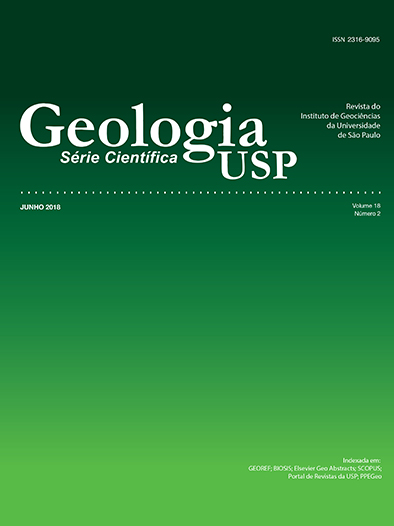Geochemical and mineralogical characterization of a section through the nickeliferous laterite in Fazenda da Roseta, Liberdade, Minas Gerais, Brazil
DOI:
https://doi.org/10.11606/issn.2316-9095.v18-122283Keywords:
Laterite profile, Nickeliferous, A-type ore, C-type ore, Garnierite, Goethite.Abstract
Geochemical and mineralogical studies undertaken through a section of the nickeliferous laterite profile in Fazenda da Roseta, Liberdade, Southern Minas Gerais, revealed mineable grades, both in the saprolitic horizon (A-type ore) and in the oxidized one (C-type ore). The A-type ore, well defined in the innermost 1.5 m of the section, boasts representative grades at the order of 1.7 wt.% NiO, with amorphous garnierite-type minerals, besides chlorite and likely serpentine, as the Ni-rich phases. An approximately 2 m-long interval defines a transitional zone from the silicatic toward the oxidized ore, marked by the outward gradual absorption of residual blocks from the parent rock within a goethitic plasma. Impregnations and stockwork-like veins of asbolane, confirmed by local Mn and Co anomalies, delineate the outer edge of this zone. The oxidized ore stretches, based on Ni contents, for roughly 4 m. Average grades lie about 1.2 wt.% NiO, containing goethite as the main Ni ore mineral, plus some secondary talc. Ever since the innermost part of the section, Ni has been continuously washed away, in such a manner that its concentrations become rather low in the outermost part. Anomalous geochemical signatures may indicate the occurrence of dykes of uncommon igneous rocks crosscutting the profile. The absence of smectites in the profile points out that free flow conditions have prevailed, which is reinforced by the substitution of kaolinite by gibbsite, which highlights severe hydrolysis conditions (tendency to alitization). Kaolinite veins in the gibbsite-only zone suggest post-lateritic origin. The laterite development determines an evolution in pH conditions from slightly alkaline in the early stages (quartz–kaolinite–zeolite association) to mildly acidic in the more advanced phases (presence of Al-goethites).
Downloads
Published
Issue
Section
License
Authors who publish in this journal shall comply with the following terms:
- Authors keep their copyright and grant to Geologia USP: Série Científica the right of first publication, with the paper under the Creative Commons BY-NC-SA license (summary of the license: https://creativecommons.org/licenses/by-nc-sa/4.0 | full text of the license: https://creativecommons.org/licenses/by-nc-sa/4.0/legalcode) that allows the non-commercial sharing of the paper and granting the proper copyrights of the first publication in this journal.
- Authors are authorized to take additional contracts separately, for non-exclusive distribution of the version of the paper published in this journal (publish in institutional repository or as a book chapter), granting the proper copyrights of first publication in this journal.
- Authors are allowed and encouraged to publish and distribute their paper online (in institutional repositories or their personal page) at any point before or during the editorial process, since this can generate productive changes as well as increase the impact and citation of the published paper (See The effect of Open Access and downloads on citation impact).





